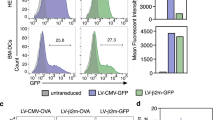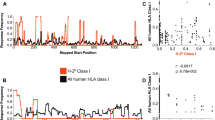Abstract
Based on observations that DBA/2 mice develop a highly specific response towards an HLA-Cw3-derived epitope, consisting entirely of CD8+CD62L-Vβ10+ cells, we have established an in vivo mouse model for screening a variety of immunization approaches. Responder cells were readily detectable in small samples of the peripheral blood using three-color FACS analysis. This permitted multiple, sequential determination of CD8+ T-cell responses in living animals at a very high degree of precision. In vivo electroporation delivery of expression construct plasmids, outclassed the other approaches tested. Dominant, specific responses were induced already upon a single administration. Both the peak and the longevity of the response resembled those that are generated by the most active viral infections. The induced CTLs rejected epitope-bearing tumor cells in vivo and released interferon-γ upon stimulation with the correct MHC::peptide combination in vitro. The potent in vivo response was not influenced by known modulators of the innate immune system, such as CpG DNA and LPS content. In vivo electroporation thus deserves consideration in the future in antitumor and antiviral immunization approaches, where CD8+ T cells play a predominant role.
This is a preview of subscription content, access via your institution
Access options
Subscribe to this journal
Receive 12 print issues and online access
$259.00 per year
only $21.58 per issue
Buy this article
- Purchase on Springer Link
- Instant access to full article PDF
Prices may be subject to local taxes which are calculated during checkout





Similar content being viewed by others
References
Murali-Krishna K et al. Counting antigen-specific CD8 T cells: a reevaluation of bystander activation during viral infection. Immunity 1998; 8: 177–187.
Hou S et al. Virus-specific CD8+ T-cell memory determined by clonal burst size. Nature 1994; 369: 652–654.
MacDonald HR et al. Oligoclonal expansion of major histocompatibility complex class I-restricted cytolytic T lymphocytes during a primary immune response in vivo: direct monitoring by flow cytometry and polymerase chain reaction. J Exp Med 1993; 177: 1487–1492.
Casanova JL et al. H-2-restricted cytolytic T lymphocytes specific for HLA display T cell receptors of limited diversity. J Exp Med 1992; 176: 439–447.
Maryanski JL et al. Single-cell PCR analysis of TCR repertoires selected by antigen in vivo: a high magnitude CD8 response is comprised of very few clones. Immunity 1996; 4: 47–55.
Bradley LM et al. Characterization of antigen-specific CD4+ effector T cells in vivo: immunization results in a transient population of MEL-14-, CD45RB-helper cells that secretes interleukin 2 (IL-2), IL-3, IL-4, and interferon gamma. J Exp Med 1991; 174: 547–559.
Walker PR et al. Distinct phenotypes of antigen-selected CD8 T cells emerge at different stages of an in vivo immune response. J Immunol 1995; 155: 3443–3452.
Rizzuto G et al. Efficient and regulated erythropoietin production by naked DNA injection and muscle electroporation. Proc Natl Acad Sci USA 1999; 96: 6417–6422.
Widera G et al. Increased DNA vaccine delivery and immunogenicity by electroporation in vivo. J Immunol 2000; 164: 4635–4640.
Zucchelli S et al. Enhancing B- and T-cell immune response to a hepatitis c virus E2 DNA vaccine by intramuscular electrical gene transfer. J Virol 2000; 74: 11598–11607.
Buschle M et al. Transloading of tumor antigen-derived peptides into antigen-presenting cells. Proc Natl Acad Sci USA 1997; 94: 3256–3261.
Schmidt W et al. Transloading of tumor cells with foreign MHC I peptide ligand: a novel general strategy for the generation of potent cancer vaccines. Proc Natl Acad Sci USA 1996; 93: 9759–9763.
Deres K et al. In vivo priming of virus-specific cytotoxic T lymphocytes with synthetic lipopeptide vaccine. Nature 1989; 342: 561–564.
Condreay JP et al. Transient and stable gene expression in mammalian cells transduced with a recombinant baculovirus vector. Proc Natl Acad Sci USA 1999; 96: 127–132.
Hofmann C et al. Efficient gene transfer into human hepatocytes by baculovirus vectors. Proc Natl Acad Sci USA 1995; 92: 10099–10103.
Busch DH et al. Coordinate regulation of complex T cell populations responding to bacterial infection. Immunity 1998; 8: 353–362.
Hemmi H et al. A Toll-like receptor recognizes bacterial DNA. Nature 2000; 408: 740–745.
Sato Y et al. Immunostimulatory DNA sequences necessary for effective intradermal gene immunization. Science 1996; 273: 352–354.
Mizushima S, Nagata S . pEF-BOS, a powerful mammalian expression vector. Nucleic Acids Res 1990; 18: 5322–5322.
Davis HL et al. CpG DNA is a potent enhancer of specific immunity in mice immunized with recombinant hepatitis B surface antigen. J Immunol 1998; 160: 870–876.
Cotten M et al. Lipopolysaccharide is a frequent contaminant of plasmid DNA preparations and can be toxic to primary human cells in the presence of adenovirus. Gene Ther 1995; 1: 239–246.
Aliprantis AO et al. Cell activation and apoptosis by bacterial lipoproteins through toll-like receptor-2. Science 1999; 285: 736–739.
Tapping RI et al. Toll-like receptor 4, but not toll-like receptor 2, is a signaling receptor for Escherichia and Salmonella lipopolysaccharides. J Immunol 2000; 165: 5780–5787.
BenMohamed L et al. Lipopeptide immunization without adjuvant induces potent and long-lasting B, T helper, and cytotoxic T lymphocyte responses against a malaria liver stage antigen in mice and chimpanzees. Eur J Immunol 1997; 27: 1242–1253.
Schneider J et al. Enhanced immunogenicity for CD8+ T cell induction and complete protective efficacy of malaria DNA vaccination by boosting with modified vaccinia virus Ankara. Nat Med 1998; 4: 397–402.
Barouch DH et al. Control of viremia and prevention of clinical AIDS in rhesus monkeys by cytokine-augmented DNA vaccination. Science 2000; 290: 486–492.
Mir LM et al. Long-term, high level in vivo gene expression after electric pulse-mediated gene transfer into skeletal muscle. C R Acad Sci III 1998; 321: 893–899.
Aihara H, Miyazaki J . Gene transfer into muscle by electro-poration in vivo. Nat Biotechnol 1998; 16: 867–870.
Akbari O et al. DNA vaccination: transfection and activation of dendritic cells as key events for immunity. J Exp Med 1999; 189: 169–178.
Boyle JS et al. Inhibitory effect of lipopolysaccharide on immune response after DNA immunization is route dependent. DNA Cell Biol 1998; 17: 343–348.
Weeratna R et al. Reduction of antigen expression from DNA vaccines by coadministered oligodeoxynucleotides. Antisense Nucl Acid Drug Dev 1998; 8: 351–356.
Paster W et al. Structural elements of a protein antigen determine immunogenicity of the embedded MHC class I-restricted T cell epitope. J Immunol 2002; 169: 2937–2946.
Kalat M et al. In vivo plasmid electroporation induces tumor antigen-specific CD8+ T cell responses and delays tumor growth in a syngeneic mouse melanoma model. Cancer Res 2002; 62: 5489–5494.
Gunzburg WH et al. A mammary-specific promoter directs expression of growth hormone not only to the mammary gland, but also to Bergman glia cells in transgenic mice. Mol Endocrinol 1991; 5: 123–133.
Attuil V et al. Comparative T cell receptor repertoire selection by antigen after adoptive transfer: a glimpse at an antigen-specific preimmune repertoire. Proc Natl Acad Sci USA 2000; 97: 8473–8478.
Acknowledgements
We thank J-C Cerottini, A Himmler, and W Günzburg for reagents, E Wagner and J Maryanski for their discussions at the initial phase of the project, and T Decker and GR Adolf for their suggestions and support.
Author information
Authors and Affiliations
Corresponding author
Rights and permissions
About this article
Cite this article
Paster, W., Zehetner, M., Kalat, M. et al. In vivo plasmid DNA electroporation generates exceptionally high levels of epitope-specific CD8+ T-cell responses. Gene Ther 10, 717–724 (2003). https://doi.org/10.1038/sj.gt.3301942
Received:
Accepted:
Published:
Issue Date:
DOI: https://doi.org/10.1038/sj.gt.3301942
Keywords
This article is cited by
-
Multi-antigen DNA vaccine delivered by polyethylenimine and Salmonella enterica in neuroblastoma mouse model
Cancer Immunology, Immunotherapy (2020)
-
Gene Therapy Progress and Prospects: Electroporation and other physical methods
Gene Therapy (2004)
-
Immune responses to gene therapy vectors: influence on vector function and effector mechanisms
Gene Therapy (2004)
-
DNA electrotransfer: its principles and an updated review of its therapeutic applications
Gene Therapy (2004)



